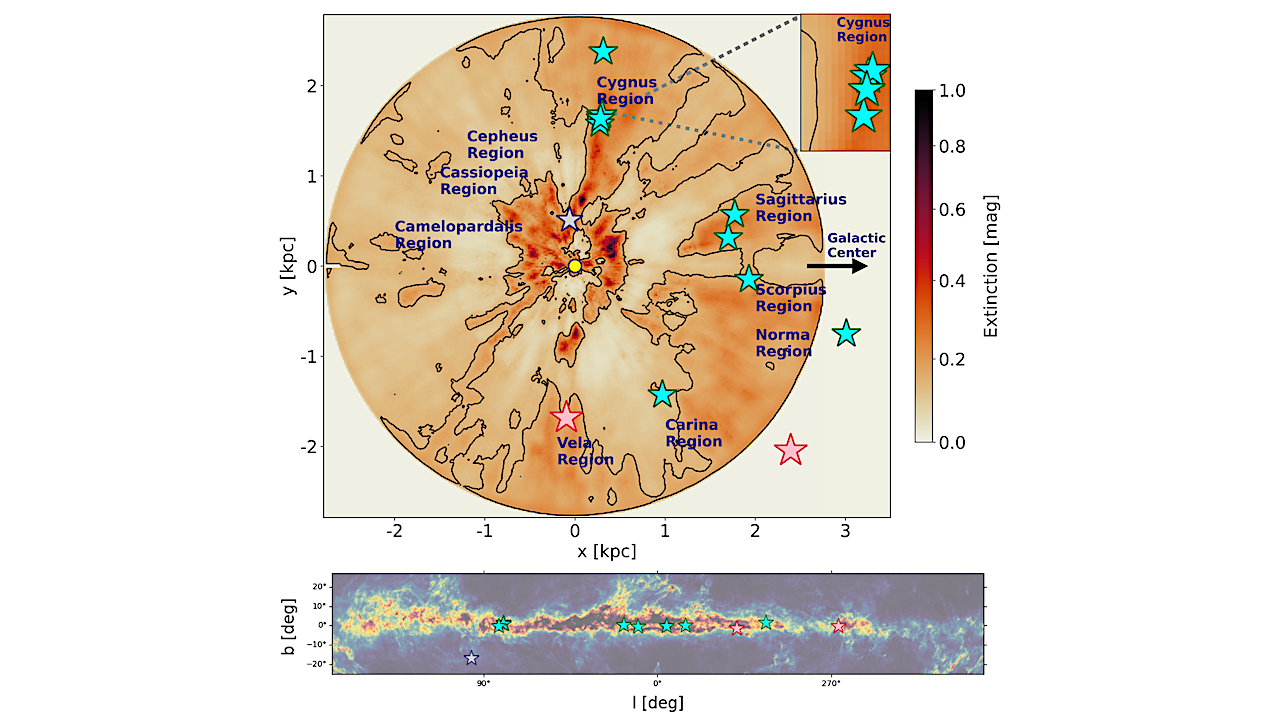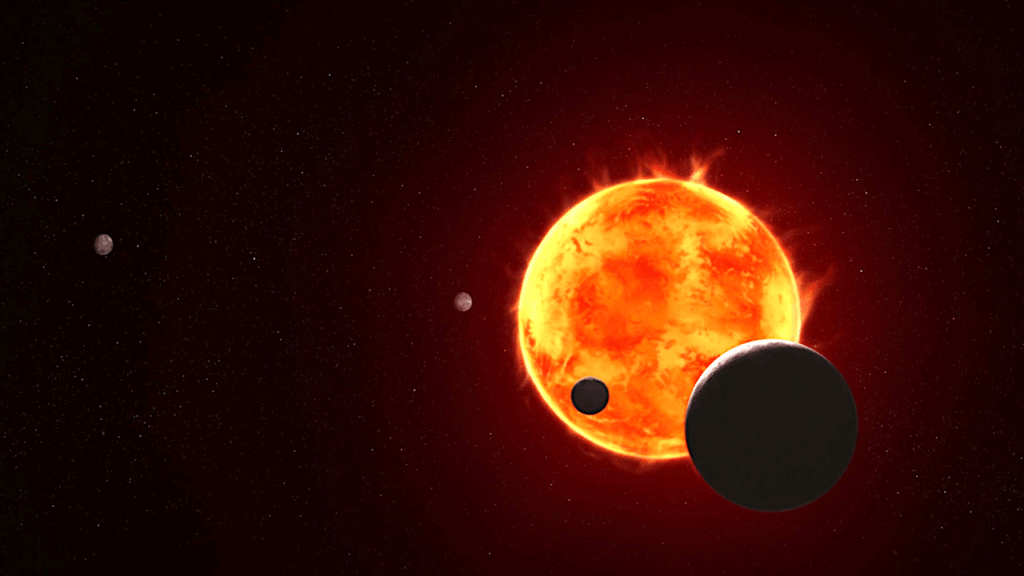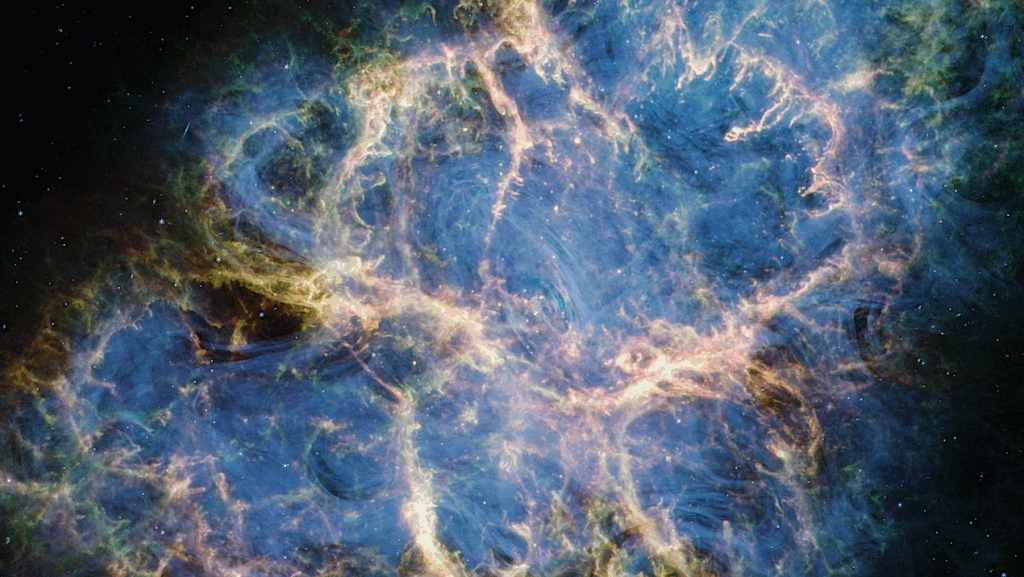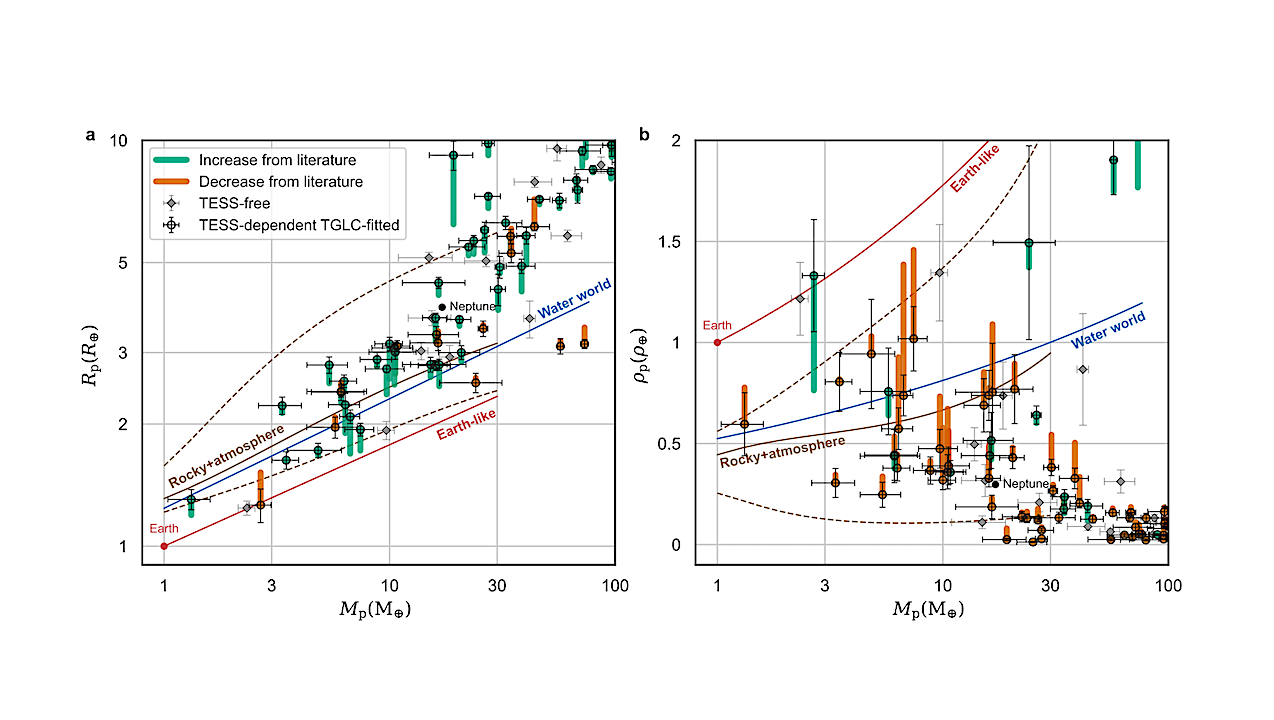Now Reading: Investigating Silicate, Carbon, And Water In The Diffuse Interstellar Medium: The First Shots From WISCI
-
01
Investigating Silicate, Carbon, And Water In The Diffuse Interstellar Medium: The First Shots From WISCI
Investigating Silicate, Carbon, And Water In The Diffuse Interstellar Medium: The First Shots From WISCI


Top: Extinction map of the local ISM viewed top-down taken from Dharmawardena et al. (2024). The Sun (yellow circle) is at X, Y = 0, 0 and the Galactic centre is at X, Y = 8.2, 0 kpc. The twelve targets (cf. Table 1) are represented by colored stars. The two stars analyzed in this paper are shown in red and the other ten are shown in blue. The small gray star near the center of this figure indicates 10 Lac (AV = 0.21 mag), which was used as a reference star. The contours represent extinction in steps of 0.2 mag. Bottom: Dust map of the Milky Way galactic plane derived from Gaia photometry (see Andrae et al. (2023) for more details) with the twelve targets following the same color scheme as above. Note that some of the targets overlap in this projection. — astro-ph.GA
The dusty interstellar medium (ISM) of the Milky Way is distributed in a complex, cloudy structure.
It is fundamental to the radiation balance within the Milky Way, provides a reaction surface to form complex molecules, and is the feedstock for future generations of stars and planets.
The life cycle of interstellar dust is not completely understood, and neither are its structure nor composition. The abundance, composition, and structure of dust in the diffuse ISM can be determined by combining infrared, optical and ultraviolet spectroscopy. JWST enables measurement of the faint absorption of ISM dust grains against bright stars at kiloparsec distances across the infrared spectrum.
Here we present an overview of the project `Webb Investigation of Silicates, Carbons, and Ices’ (WISCI) along with interpretation of two targets, GSC 08152-02121 and CPD-59 5831. Observations of 12 WISCI target stars were taken by JWST, the Hubble Space Telescope, Himalayan Chandra Telescope, and the Very Large Telescope.
We use these to characterize the targets’ spectral types and calculate their line-of-sight extinction parameters, AV and RV. We find absorption in the JWST spectra of GSC 08152-02121, and CPD-59 5831 associated with carbonaceous dust around 3.4 and 6.2 micron and amorphous silicates at 9.7 micron.
In GSC 08152-02121 we also find indications of absorption by trapped water around 3 micron. This first look from WISCI demonstrates the line-of-sight variability within the sample, and the program’s potential to identify and correlate features across ultraviolet to mid-infrared wavelengths.
S.T. Zeegers, Jonathan P. Marshall, Karl D. Gordon, Karl A. Misselt, G.P.P.L. Otten, Jeroen Bouwman, Jean Chiar, Marjorie Decleir, Thavisha Dharmawardena, F. Kemper, Aigen Li, Mayank Narang, Alexey Potapov, Manoj Puravankara, Peter Scicluna, Himanshu Tyagi, Eleonora Zari, ChuanYu Wei, Lex Kaper, Frank Backs, Stefan T. Bromley, Laurie Chu, Elisa Costantini, T. R. Geballe, Joel D. Green, Chamani Gunasekera, Burcu Günay, Thomas Henning, Olivia Jones, Joan Mariñoso Guiu, Melissa McClure, Yvonne J. Pendleton, Julia C. Roman-Duval, Tomer Shenar, Alexander G.G.M. Tielens, L. B. F. M. Waters
Comments: Accepted for publication in ApJ
Subjects: Astrophysics of Galaxies (astro-ph.GA); Solar and Stellar Astrophysics (astro-ph.SR)
Cite as: arXiv:2506.20033 [astro-ph.GA] (or arXiv:2506.20033v1 [astro-ph.GA] for this version)
https://doi.org/10.48550/arXiv.2506.20033
Focus to learn more
Related DOI:
https://doi.org/10.3847/1538-4357/add73b
Focus to learn more
Submission history
From: Sascha Zeegers Dr.
[v1] Tue, 24 Jun 2025 22:10:27 UTC (3,402 KB)
https://arxiv.org/abs/2506.20033
Astrobiology, Astrochemistry,
Stay Informed With the Latest & Most Important News
Previous Post
Next Post
-
 012024 in Review: Highlights from NASA in Silicon Valley
012024 in Review: Highlights from NASA in Silicon Valley -
 02Panasonic Leica Summilux DG 15mm f/1.7 ASPH review
02Panasonic Leica Summilux DG 15mm f/1.7 ASPH review -
 03How New NASA, India Earth Satellite NISAR Will See Earth
03How New NASA, India Earth Satellite NISAR Will See Earth -
 04And Thus Begins A New Year For Life On Earth
04And Thus Begins A New Year For Life On Earth -
 05Astronomy Activation Ambassadors: A New Era
05Astronomy Activation Ambassadors: A New Era -
06SpaceX launch surge helps set new global launch record in 2024
-
 07From Polymerization-Enabled Folding and Assembly to Chemical Evolution: Key Processes for Emergence of Functional Polymers in the Origin of Life
07From Polymerization-Enabled Folding and Assembly to Chemical Evolution: Key Processes for Emergence of Functional Polymers in the Origin of Life




















